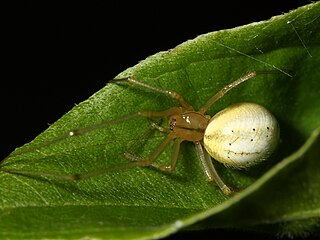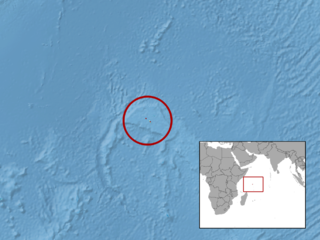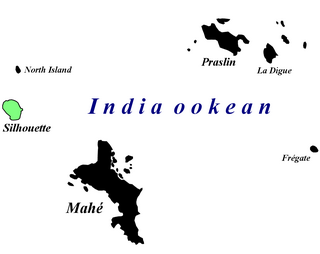
Theridiidae, also known as the tangle-web spiders, cobweb spiders and comb-footed spiders, is a large family of araneomorph spiders first described by Carl Jakob Sundevall in 1833. This diverse, globally distributed family includes over 3,000 species in 124 genera, and is the most common arthropod found in human dwellings throughout the world.

Brauer's burrowing skink, also known commonly as Brauer's skink, is a species of lizard in the family Scincidae. The species is endemic to the Seychelles.

Platnickina is a genus of comb-footed spiders that was first described by A. Ö. Koçak & M. Kemal in 2008.
Andasta is a genus of ray spiders that was first described by Eugène Louis Simon in 1895.
Apolania is a monotypic genus of East African wandering spiders containing the single species, Apolania segmentata, first described from a male found by Eugène Simon in 1898. No females have been described yet, and it has only been found in Seychelles.
Argyrodella is a monotypic genus of Seychelloise comb-footed spiders containing the single species, Argyrodella pusillus. It was first described by Michael I. Saaristo in 2006, and is found on the Seychelles.
Zoma zoma is a species of ray spider that is endemic to Silhouette Island of Seychelles. It was first described by Michael I. Saaristo & A. V. Tanasevitch in 1996. To date Zoma only contains its type species Zoma Zoma. The name of Zoma refers to the belt of silvery corpuscles on the abdomen of the type species. Not much is known about males of the species. Females have a total length, not including chelicerae, of 1.79 mm. It is threatened by habitat degradation from invasive plants, such as Cinnamomum verum.
Pleorotus was a monotypic genus of Seychelloise huntsman spiders containing the single species, Pleorotus braueri. It was first described by Eugène Louis Simon in 1898, and was endemic to the Seychelles. The description was based on a single male collected on Mahe Island in 1894, but none have been found in later collections, and it has been declared extinct.
Zoma is a genus of ray spiders that was first described by Michael I. Saaristo in 1996. As of June 2020 it contains three species, found in Japan, China, and on the Seychelles: Z. dibaiyin, Z. fascia, and Z. zoma.
Cenemus is a genus of Seychelloise cellar spiders that was first described by Michael I. Saaristo in 2001. As of June 2019 it contains only three species, found only on the Seychelles: C. culiculus, C. mikehilli, and C. silhouette.
Theoa is a genus of sheet weavers that was first described by Michael I. Saaristo in 1995.
Nanume is a monotypic genus of comb-footed spiders containing the single species, Nanume naneum. It was first described by Michael I. Saaristo in 2006, and is found on the Aldabra Atoll.
Sesato is a monotypic genus of African comb-footed spiders containing the single species, Sesato setosa. It was first described by Michael I. Saaristo in 2006, and is found on the Seychelles.
Spinembolia is a monotypic genus of African comb-footed spiders containing the single species, Spinembolia clabnum. It was first described by Michael I. Saaristo in 2006, and is found on the Seychelles.
Stoda is a monotypic genus of African comb-footed spiders containing the single species, Stoda libudum. It was first described by Michael I. Saaristo in 2006, and is found on the Seychelles.
Michael I. Saaristo was a Finnish arachnologist, with a particular interest in the spiders of the Seychelles. The World Spider Catalog lists 61 genus names or synonyms and 109 species names or synonyms of which he is the sole or co-author.
Bardala labarda is the only species in the monotypic genus Bardala, a member of the comb-footed spider family Theridiidae. It was first described by Michael I. Saaristo in 2006, and is endemic to the coral atoll of Aldabra.
Centrobunus braueri is an extinct species of arachnids in the order Opiliones, endemic to the Seychelles island of Mahé, where it was found in 1894. No other sightings have been recorded of this species, despite efforts to find it again in suitable habitats. Therefore the species has been declared as extinct. Habitat deforestation due to the introduction of the cinnamon tree Cinnamomum verum has been determined to be the cause of extinction.

Afrolychas braueri, commonly known as the Seychelles forest scorpion, is a species of scorpion in the family Buthidae. It is currently thought to survive only on Silhouette Island, Seychelles, although the species was historically found on two additional Seychellois islands. This scorpion lives in leaf litter in forests that are largely unaffected by invasive plant species. It is a small yellowish-brown scorpion with three prominent keels on the dorsal surface of its mesosoma, which distinguishes it from other scorpions. While not much is known about the Seychelles forest scorpion's ecology due to the paucity of sightings, it is known to rely solely on its venom to capture its prey and defend its young. Its venom is not dangerous to humans.

Cosmophasis lami, also known as the Lami Beach northern jumping spider or tangerine garden jumper, is a species of jumping spider in the genus Cosmophasis, probably native to South East Asia and some pacific islands, and possibly introduced to Japan and Okinawa Islands by humans. It was first described by Berry, Beatty & Prószynski in 1997 and has one synonym, Cosmophasis squamata (Saaristo,2002) Both the female and the male have been described.





